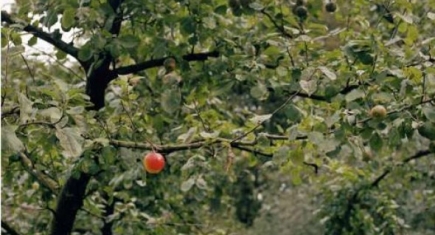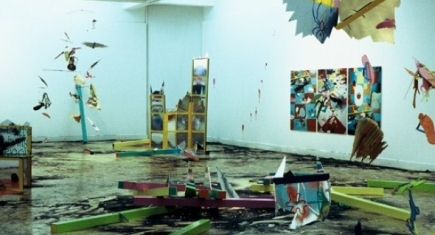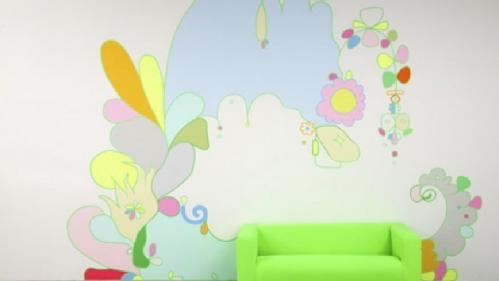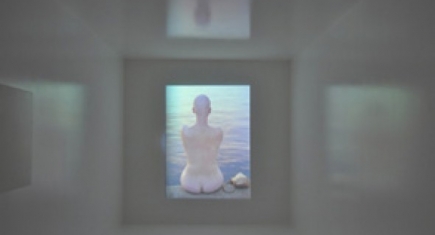Mead Gallery Exhibitions 2004
Mandy Lee Jandrell: Where the Grass is Green
A Mead Gallery Exhibition
Sat 6 Nov – Sat 4 Dec 2004
The casual humour of South African photographer Mandy Lee Jandrell’s snapshot style evokes the engrained practices of cultural tourism She scours wildlife parks, botanical gardens, historical recreations and themes parks – the spaces of leisure – for her subject matter, exploring the pre-packaging of our perceptions of the ‘real’ and the belief systems that sustain them. This exhibition brings together a new body of work examining ideas of paradise.
David Burrows: New Life
A collaboration between the Mead Gallery and the Chisenhale Gallery
Mon 27 Sep – Sat 4 Dec 2004
Strewn through the gallery a baroque assemblage of debris appears to have been created by a recent catastrophe, violent event or frenzied celebration. Ripped shoes and fragments of clothing, suspended in motion, are arranged against a backdrop of damaged architectural structures. Large-scale photographic tableaux, influenced by shop window display, depict apparent consumer chaos.
This initial impression of devastation in New Life is interrupted by immaculate attention to detail, saturated colours and a floor that sparkles with grey dust. The ruins of New Life propose an air of optimism and joy.
The Mythological Machine: Images in the Media
Curated by Francesco Manacorda for the Mead Gallery
Mon 27 Sep – Fri 29 Oct 2004
Erick Beltran, Phil Collins, Maria Friberg, Rainer Ganahl, Alasdair Hopwood, Cristobal Leyt, Mark Lombardi, Nate Lowman, Daniel Pflumm, Jim Shaw, Sean Snyder, Cesare Viel, Olav Westphalen,
The way in which the trauma of 9/11 has been elaborated by the information industry – the mass media of newspapers and television – is the touchstone for the works presented in this exhibition. The media increasingly generates visuals very similar to those used by the entertainment industry, drawing on the emotive and unconscious effects of a vast repertoire of images. Included works question or generate a position of doubt, putting the viewer in an uneasy position: the presentation of the real is questioned as mythological construction.
Supported by Arts Council England, The Henry Moore Foundation, Pro-Helvetia and La Collection Jumex.
EXPO21: Strategies of Display
An Angel Row Gallery Touring Exhibition
Sat 29 May – Sat 26 Jun 2004
Artists: Shahin Afrassiabi, Loris Cecchini, Gareth Jones, Goshka Macuga, Mathieu Mercier, Simon Moretti and Elisa Sighicelli.
Curated by Simon Moretti
EXPO21: Strategies of Display brings together seven artists from France, Italy and the UK whose work explores ideas about display and the presentation of objects in museums, galleries and in broader contemporary culture.
The work in the exhibition also refers to the visual trappings and materials of display and display spaces, to trade fares, the retail environment and shop window. An interest in framing, revealing, arranging and ‘drawing attention to’ is apparent in much of the work and the exhibition brings to the foreground the importance of display in contemporary fine art practice.
Shahin Afrassiabi’s installations are constructed from standard building materials. These objects are informally arranged – often propped up or leaning – yet they are placed in ways too deliberate to be casual or unplanned.
‘Piet x 4 2004’, is a new work commissioned for the gallery. Afrassiabi takes a typical gridded painting by Piet Mondrian and reproduces the grid in three dimensions with ordinary scaffolding. ‘Evening Post 8 July 2003 Poster series: Red and Blue’ is a group of prints showing enlarged details from an edition of the Nottingham Evening Post. The abstracted graphics appear quite random, yet each detail is carefully selected, framed and positioned.
Afrassiabi has said, “Architecture provides spaces to be filled. I’m starting from spaces that are already filled: the way a curtain inhabits and expands the idea of a window, or a painting extends and decorates a wall. I’m looking at all of this, from the clothes we wear, to the objects we use, to the place we inhabit….” (Sculpture Forever: Contemporary Sculpture Part 1; Flash Art no. 230, May-June 2003).
Loris Cecchini transforms mundane objects like computer hardware into sprawling domestic landscapes by casting them in rubber, thereby making them ‘useless’ but at the same time giving them a new life. One of these sculptures ‘Stage Evidence (untitled)’, 2000, is shown in this exhibition. In a review of its installation at the Centro Galego de Arte Contemporanea, Santiago in 2000, Gianmarco Del Re describes Cecchini’s rubber casts of computer technology as “an archaeology of the twentieth century”. He remarks on how Cecchini “uses light to enhance the artificiality of his digitally manipulated images and stress an underlying sense of alienation.” (Contemporary Visual Arts; Issue 30)
Something of this is also evident in ‘Monologue Patterns (squatter)’, 2003 – a minutely detailed and finely constructed model living space. This dwelling is raised high on stilts, amongst the power cables, removed and isolated from the world below.
Gareth Jones works with “unvalued materials and forgotten or unimportant objects, using a non-representational vocabulary of forms to create works with a simplicity of shape and construction” (Delfina website). Whatever the materials, they are manipulated with absolute precision and attention to detail.
Recent work includes a series of structures based on the shape and dimensions of a standard plinth, a simple and elegant role reversal that turns an ordinary piece of gallery furniture into the “art to be viewed”. Each plinth is modified, embellished, distorted and given an individual identity, yet each remains somehow connected to the others. ‘Modular Plinth’, 2003, is based on three 30 × 30 × 30cm cubes, each one dissected into parts which might be shown whole but could also be assembled and re-assembled like a geometry puzzle. ‘Illustrated Plinth’, 2004 is covered with a drawing based on a William Morris design, the delicate repeat pattern spilling over the sides of the structure. ‘Tape Box’, 2004, filled with the unravelled tape of cassettes that the artist listened to whilst making ‘Illustrated Plinth’.
Goshka Macuga creates installations that question the role of the curator, the artist and the collector. She often includes the work of other artists in the environments she creates, effectively curating an “exhibition within an exhibition”. Her work poses questions for the “art market”, challenging conventional methods of displaying art, “the boundaries of authorship, the protocols of lending, networks of personal relationships and the demands of ownership.”
Simon Moretti has curated EXPO21: Strategies of Display and his interests as a curator are also reflected in his work, which draws inspiration from the icons of art history, such as the readymades of Marcel Duchamp. He raises questions about display, authorship and authenticity.
‘Ideal Standard’, 2004 is his most recent neon piece and quotes the logo of the famous manufacturer of bathroom suites. Translated into the material of illuminated street signage and removed from its usual context, the logo takes on new associations.
In ‘A Space for Conversation (Habitat Version, 2004)’, he uses readymade materials and refers to window dressing and shop display, to create an “information island” in the middle of the gallery. The furniture and accessories are from Habitat – a company whose design aesthetic has transformed the way we think about interiors and Moretti is interested in the way goods are displayed (“never one vase on its own, always two”) in order to entice the buyer. Books selected by the artist hint at ideas and references in both this work and the wider exhibition and visitors are invited to sit, browse, read and make their own links.
His work often invites interaction from the audience in this way. This interest in the engagement of audience with display, object and architectural space led to his work with architects Caruso St John on their Phase 1 refurbishment/redisplay of the (V&A) Museum of Childhood at Bethnal Green, London (2003).
For this exhibition Moretti has collaborated with Goshka Macuga to produce a new work specific to Mead Gallery and The University of Warwick Collection. Inspired by the decorative use of standard pallets in garden centres, they have designed a platform for the display of ceramics from the University collection and from Moretti’s home.
Mathieu Mercier became known in the 1990s for “furniture-style” objects, paintings and “DIY pieces” inspired by the world of domestic hobbies. His sculpture highlights objects that we often overlook, such as cardboard boxes and packaging, office equipment and – in the case of ‘Casque’, 1998 – a crash helmet. He makes references to advertising and the market economy, to mass production and modern art history and has said of his sculptures: “They’re in between construction and deconstruction. I use furniture and its relationship with daily life to shake up simple assumptions” (said to Olivier Gagnere in the exhibition catalogue for Absolut Generations, 2003).
Elisa Sigicelli’s evocative light box photographs bring beauty to images of sparse interior spaces that might otherwise appear commonplace. The rooms are empty, yet seem to be waiting for a human presence; they have the tension of a stage set before the play begins. As she says, “this very absence is revealing of the stay of many visitors. The manipulation of light and space, both within the image and, by extension, in the room in which it is displayed, is a strong feature of the work and Sighicelli has talked about her fascination with the light and space in Italian Romanic and Baroque churches: “light from outside becomes like a presence from ‘beyond’ and makes the building alive. In my work light suggests a presence but does not actually reveal much.” (Published in Slade by The Slade School of Fine Art, 2003).
EXPO21: Strategies of Display is an Angel Row Gallery touring exhibition funded by Arts Council England’s National Touring Programme and The Henry Moore Foundation.
A Kind of Bliss: Polly Apfelbaum, Katy Dove, Len Lye, Lily van der Stokker
A collaboration between the Mead Gallery and The Drawing Room, London
Sat 29 May – Sat 26 Jun 2004
“Colour is like a closing eyelid, a tiny fainting spell, a kind of bliss”.
Roland Barthes
The title of this exhibition comes from an essay by Roland Barthes in which he discusses the work of the artist Cy Twombly. Barthes argues that in Twombly’s work ‘colour, like the event, is new every time. It is precisely the stroke that makes the colour – as it produces bliss’. He links colour with the act of drawing, suggesting that colour is activated by the ‘gesture, the pleasure of the gesture’.
Colour is usually associated with the process of painting and its reliance on the medium of pigment to describe tone or form. The four artists in this exhibition employ the use of colour through the act of drawing to describe a personal and sensory experience of life. Using line and form in harmony with colour rather than in opposition, they attempt to marry the formal and conceptual in works that make conspicuous the trace of the artist’s hand.
'A Kind of Bliss’ presents an intentional cross-generational dialogue between artists of international standing. Polly Apfelbaum draws with dye and scissors. She creates sumptuous colourful compositions arranged on the floor, spreading outwards and around surfaces to challenge traditional boundaries. In Lily van der Stokker’s wall paintings of candy coloured shapes, succinct words and sentences spill out from the surface. She often uses items of furniture or built constructions to position the work within the space. Len Lye’s experimental film work serves as an introduction to the contemporary work. His innovative technique of drawing directly onto the film has subsequently inspired many artists. Katy Dove shares a similar sensibility in her use of line, colour and musical notation to build colourful abstract compositions. Notwithstanding difference in generation and gender, both use an intuitive combination of line and colour to create playful, hypnotic animations. All four artists in this exhibition share a visual language made up of pictorial elements: line, form and plane that can be compared to a musical score.
This exhibition marks an important collaboration between The Drawing Room and the Mead Gallery. The Drawing Room is a non-profit gallery whose programme addresses contemporary drawing in all its forms. The Mead Gallery’s programme is concerned to contextualise contemporary work and connect it to the work of the last forty years which is held in the University’s collections. We share a commitment to supporting the development of new work and to creating exhibitions that engage ideas and experiences of contemporary living.
Exhibition supported by Arts Council England and the Mondrian Foundation
Antony McCall: Film Installations
A Mead Gallery Exhibition
Wed 21 Apr – Wed 19 May 2004
In January 1973 Anthony McCall conceived his first ‘solid light’ film, Line Describing a Cone, shown for the first time in Stockholm later that year, McCall’s film is an extraordinary sensuous meditation upon the medium of film and the politics of the audience’s physical and conceptual relationship with it. Some thirty years later, this work is being shown again as part of an exhibition at the Mead Gallery focusing on McCall’s development of the ‘solid light’ film.
Story of the Eye: Knut Asdam, A.K. Dolven, Dan Graham
A Mead Gallery Exhibition
Fri 16 Jan – Fri 12 Mar 2004
This show takes its title from a revolutionary short novel by the French writer George Bataille. ‘Histoire de l’oeil’ shatters conventional approaches to reading. It asks us to revise our relationship with the form, imagery and meaning of the text. The book is also concerned to shift the notion of vision from a process of the mind to a practice intimately connected with the physicality of the body. Similarly, this exhibition seeks to challenge the viewer’s relationship to the work of art by asking them to position themselves within works in the show and to consider their own physical and perceptual responses to the environments and images they encounter.
‘between the morning and the handbag II’ by A.K. Dolven forms both an entrance to the exhibition and a barrier to the spectator. Its ten metre long wooden structure has to be physically negotiated by the viewer in order to observe the double projection within it. The architecture frames the spectator as much as the image, positioning the viewer between two scenes. The far doorway offers a view of Dolven’s second work, 2:57, a large-scale projection of a forest landscape. The hypnotic effect of these images is counter balanced by tight framing and careful control of the relationship between foreground and background.
‘Opposing Mirrors and Video Monitors on Time Delay’ is a key early work by Dan Graham. In the mid-seventies Graham produced a series of works using materials such as mirrors, reflective glass and video cameras that incorporated the audience within the work of art. These works allow spectators to observe their own responses to the piece and their reactions to the presence of other viewers occupying the same space. This work includes a video camera that relays the recorded image to a video monitor on the other side of the room only after a five second delay. As the individual’s recent past is displaced from their present it becomes possible for them to observe themselves in the more objective, distanced way that they might observe others.
Knut Asdam extends the social implications of Graham’s work. ‘Psychasthenia 10 Series 2’ presents melancholic images of decaying urban tower blocks shot at night. These images contrast sharply with the soft curtain enclosure that surrounds them, as does the architecture of the gallery itself. The projected images dissolve into each other creating a seductive dream like environment. ‘Filter City’ is a new film work by Asdam that continues his interest in the relationship between social and architectural practice. The scripted narrative follows two female figures who play out their relationship in public spaces between the architectural structures of the city.
The Mead Gallery has a history of presenting work commissioned to address its space. In this exhibition the viewer becomes an acknowledged participant and their active responses to the works are central to the conception of the show.




